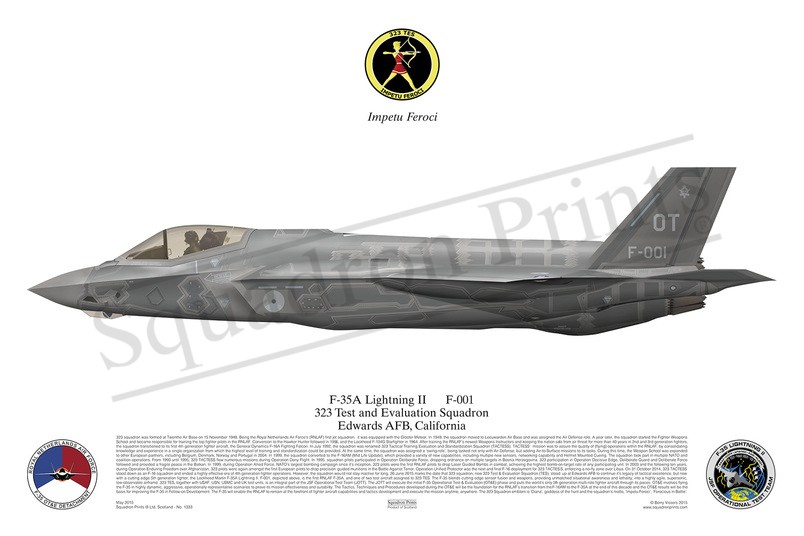#1333 F-35A Lightning II

Purchased products will not feature the Squadron Prints watermark
Description
Squadron Prints Lithograph No. 1333 - F-001, F-35A Lightning II, 323 Test and Evaluation Squadron, Edwards AFB, California.
323 squadron was formed at Twenthe Air Base on 15 November 1948. Being the Royal Netherlands Air Force’s (RNLAF) first jet squadron, it was equipped with the Gloster Meteor. In 1949, the squadron moved to Leeuwarden Air Base and was assigned the Air Defense role. A year later, the squadron started the Fighter Weapons School and became responsible for training the top fighter pilots in the RNLAF. Conversion to the Hawker Hunter followed in 1956, and the Lockheed F-104G Starfighter in 1964. After training the RNLAF’s newest Weapons Instructors and keeping the nation safe from air threat for more than 40 years in 2nd and 3rd generation fighters, the squadron transitioned to its first 4th generation fighter aircraft, the General Dynamics F-16A Fighting Falcon. In July 1992, the squadron was renamed 323 Tactical Training Evaluation and Standardization Squadron (TACTESS). TACTESS’ mission was to assure the quality of (flying) operations within the RNLAF, by consolidating knowledge and experience in a single organization from which the highest level of training and standardization could be provided. At the same time, the squadron was assigned a ‘swing-role’, being tasked not only with Air Defense, but adding Air-to-Surface missions to its tasks. During this time, the Weapon School was expanded to other European partners, including Belgium, Denmark, Norway and Portugal in 2004. In 1999, the squadron converted to the F-16AM (Mid Life Update), which provided a variety of new capabilities, including multiple new sensors, networking capability and Helmet Mounted Cueing. The squadron took part in multiple NATO and coalition operations. From 1993 until 1995, 323 TACTESS flew numerous missions during Operation Deny Flight. In 1995, squadron pilots participated in Operation Deliberate Force, dropping ordnance on multiple targets in Bosnia Herzegovina. 323 participation in Operation Decisive Edge, Deliberate Guard and Deliberate Force followed and provided a fragile peace in the Balkan. In 1999, during Operation Allied Force, NATO’s largest bombing campaign since it’s inception, 323 pilots were the first RNLAF pilots to drop Laser Guided Bombs in combat, achieving the highest bomb-on-target rate of any participating unit. In 2003 and the following ten years, during Operation Enduring Freedom over Afghanistan, 323 pilots were again amongst the first European pilots to drop precision guided munitions in the Battle Against Terror. Operation Unified Protector was the next and final F-16 deployment for 323 TACTESS, enforcing a no-fly zone over Libya. On 31 October 2014, 323 TACTESS stood down as an F-16 squadron and ended a highly effective era of 4th generation fighter operations. However, the squadron would not stay inactive for long. 26 June 2015 marks the date that 323 squadron, now 323 Test & Evaluation Squadron (TES), stood up at Edwards AFB to continue it’s legacy of tactical excellence, but now with a cutting edge 5th generation fighter, the Lockheed Martin F-35A Lightning II. F-001, depicted above, is the first RNLAF F-35A, and one of two test aircraft assigned to 323 TES. The F-35 blends cutting edge sensor fusion and weapons, providing unmatched situational awareness and lethality, into a highly agile, supersonic, low-observable airframe. 323 TES, together with USAF, USN, USMC and UK test units, is an integral part of the JSF Operational Test Team (JOTT). The JOTT will execute the initial F-35 Operational Test & Evaluation (OT&E) phase and puts the world’s only 5th generation multi-role fighter aircraft through its paces. OT&E involves flying the F-35 in highly dynamic, aggressive, operationally representative scenarios to prove its mission effectiveness and suitability. The Tactics, Techniques and Procedures developed during the OT&E will be the foundation for the RNLAF’s transition from the F-16AM to the F-35A at the end of this decade and the OT&E results will be the basis for improving the F-35 in Follow-on Development. The F-35 will enable the RNLAF to remain at the forefront of fighter aircraft capabilities and tactics development and execute the mission anytime, anywhere. The 323 Squadron emblem is ‘Diana’, goddess of the hunt and the squadron’s motto, ‘Impetu Feroci’, ‘Ferocious in Battle’.
You may also like
-
2nd Flying Wing Typhoon print
313; 1005; 802410 Sqn; 80 Sqn; 3 SqnTaif, King Fahad AB -
Coronation Flypast print (Typhoon element)
11 Sqn; 41 Sqn; 6 Sqn; 29 Sqn; 12 Sqn; 1 Sqn; 2 Sqn; 3 Sqn; 9 SqnRAF Lossiemouth; RAF Coningsby -
422 TES and 59 TES print
80-0242; 87-0362; 90-0258; 04-4069; 17-5241422 TES, 53 Wing; 59 TES, 53 WingNellis AFB, Nevada
